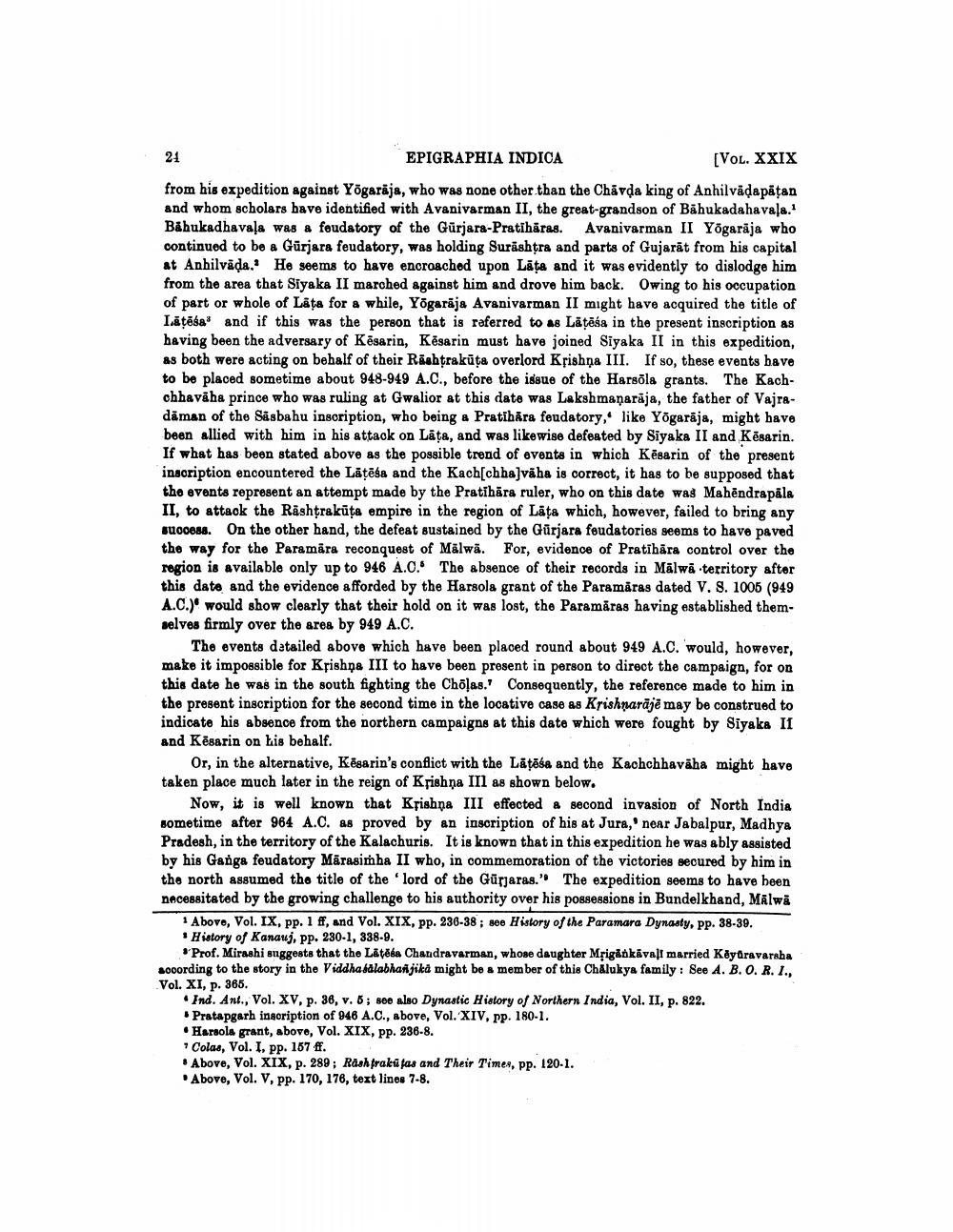________________
21
EPIGRAPHIA INDICA
[VOL. XXIX
from his expedition against Yogaraja, who was none other than the Chavda king of Anhilvāḍapāṭan and whom scholars have identified with Avanivarman II, the great-grandson of Bahukadahavala.1 Bahukadhavala was a feudatory of the Gurjara-Pratihāras. Avanivarman II Yōgarāja who continued to be a Gurjara feudatory, was holding Surashtra and parts of Gujarat from his capital at Anhilväda. He seems to have encroached upon Lata and it was evidently to dislodge him from the area that Siyaka II marched against him and drove him back. Owing to his occupation of part or whole of Lata for a while, Yogaraja Avanivarman II might have acquired the title of Latesa and if this was the person that is referred to as Latesa in the present inscription as having been the adversary of Kesarin, Kesarin must have joined Siyaka II in this expedition, as both were acting on behalf of their Rashtrakuta overlord Krishna III. If so, these events have to be placed sometime about 948-949 A.C., before the issue of the Harsōla grants. The Kachchhavaha prince who was ruling at Gwalior at this date was Lakshmanaraja, the father of Vajradaman of the Sasbahu inscription, who being a Pratihara feudatory, like Yogaraja, might have been allied with him in his attack on Lata, and was likewise defeated by Siyaka II and Kesarin. If what has been stated above as the possible trend of events in which Kesarin of the present inscription encountered the Laṭēsa and the Kach[chha]väha is correct, it has to be supposed that the events represent an attempt made by the Pratihara ruler, who on this date was Mahendrapala II, to attack the Rashtrakuta empire in the region of Lata which, however, failed to bring any success. On the other hand, the defeat sustained by the Gurjara feudatories seems to have paved the way for the Paramara reconquest of Malwa. For, evidence of Pratihara control over the region is available only up to 946 A.C. The absence of their records in Malwa territory after this date and the evidence afforded by the Harsola grant of the Paramāras dated V. S. 1005 (949 A.C.) would show clearly that their hold on it was lost, the Paramāras having established themselves firmly over the area by 949 A.C.
The events detailed above which have been placed round about 949 A.C. would, however, make it impossible for Krishna III to have been present in person to direct the campaign, for on this date he was in the south fighting the Cholas. Consequently, the reference made to him in the present inscription for the second time in the locative case as Krishnarajë may be construed to indicate his absence from the northern campaigns at this date which were fought by Siyaka II and Kesarin on his behalf.
Or, in the alternative, Kesarin's conflict with the Latesa and the Kachchhavaha might have taken place much later in the reign of Krishna IIl as shown below.
Now, it is well known that Krishna III effected a second invasion of North India sometime after 964 A.C. as proved by an inscription of his at Jura,' near Jabalpur, Madhya Pradesh, in the territory of the Kalachuris. It is known that in this expedition he was ably assisted by his Ganga feudatory Marasimha II who, in commemoration of the victories secured by him in the north assumed the title of the 'lord of the Gurjaras." The expedition seems to have been necessitated by the growing challenge to his authority over his possessions in Bundelkhand, Malwa
1 Above, Vol. IX, pp. 1 ff, and Vol. XIX, pp. 236-38; see History of the Paramara Dynasty, pp. 38-39. History of Kanauj, pp. 230-1, 338-9.
Prof. Mirashi suggests that the Lateéa Chandravarman, whose daughter Mrigankavall married Keyûravarsha according to the story in the Viddhasalabhanjikä might be a member of this Chalukya family: See A. B. O. R. I., Vol. XI, p. 365.
Ind. Ant., Vol. XV, p. 36, v. 5; see also Dynastic History of Northern India, Vol. II, p. 822.
Pratapgarh inscription of 946 A.C., above, Vol. XIV, pp. 180-1.
• Harsola grant, above, Vol. XIX, pp. 236-8.
"Colas, Vol. I, pp. 157 ff.
Above, Vol. XIX, p. 289; Rashtrakutas and Their Times, pp. 120-1.
Above, Vol. V, pp. 170, 176, text lines 7-8.




